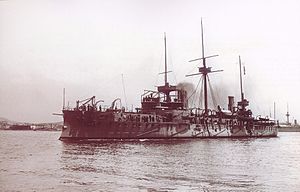Greek battleship Psara

Psara – Θ/Κ Ψαρά
|
|
| History | |
|---|---|
|
|
|
| Namesake: | Psara Island |
| Ordered: | 1885 |
| Builder: | Le Havre Shipyards |
| Launched: | 1890 |
| Fate: | sold for scrap 1932 |
| General characteristics | |
| Class and type: | Hydra class ironclad |
| Displacement: | 4,808 t (4,732 long tons; 5,300 short tons) |
| Length: | 334 feet 8 inches (102.01 m) |
| Beam: | 51 ft 10 in (15.80 m) |
| Draft: | 18 ft (5.5 m) |
| Propulsion: | 2 steam engines |
| Speed: | 17 kn (31 km/h; 20 mph) |
| Crew: | 400 |
| Armament: |
|
| Armor: |
|
Psara (Greek: Θ/Κ Ψαρά) was a steel-built ironclad warship named for one of the Aegean Sea islands that played a key role in the war at sea during the Greek War of Independence. The final vessel of the Hydra class, she was ordered in 1885 in response to a crisis in the Balkans and Ottoman naval expansion. The ship was launched in 1889 and delivered to Greece by 1902. She was armed with a main battery of three 10.8 in (270 mm) guns and five 5.9 in (150 mm) guns, and had a top speed of 17 kn (31 km/h; 20 mph).
Psara and her sisters saw extensive service with the Greek Navy. They participated in the Greco–Turkish War in 1897 until the Great Powers intervened and prevented the Greek Navy from capitalizing on their superiority over the Ottoman Navy. Psara saw action in the First Balkan War at the Naval Battle of Elli and was present at the Naval Battle of Lemnos, but was too slow to actively engage the Ottoman forces. She did not see action during World War I, and was reduced to a training ship for stokers after the end of the war. She was ultimately broken up for scrap in 1932.
In 1885, Greece ordered three new ironclads of the Hydra class.Psara was ordered from the Société Nouvelle des Forges et Chantiers de la Méditerranée shipyard in Le Havre, France during the premiership of Charilaos Trikoupis. The ship, named for the island of Psara, was launched in 1890, and by 1892, she and her sister-ships Spetsai and Hydra were delivered to the Greek fleet. The ship was 334 feet 8 inches (102.01 m) long between perpendiculars and had a beam of 51 ft 10 in (15.80 m) and a mean draft of 18 ft (5.5 m). She displaced 4,808 metric tons (4,732 long tons; 5,300 short tons) as built. She was powered by a pair of steam engines of unknown type; they were rated at 6,700 indicated horsepower (5,000 kW) and provided a top speed of 17 knots (31 km/h; 20 mph). Coal storage amounted to 500 t (490 long tons; 550 short tons).
...
Wikipedia
